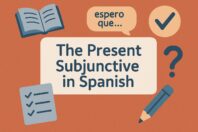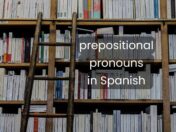Spanish Accent Marks: A full guide on accent marks in Spanish

Get our free email course, Shortcut to Conversational.
Have conversations faster, understand people when they speak fast, and other tested tips to learn faster.
More infoIn Spanish, accent marks are essential elements in proper spelling, while also indicating essential information on pronunciation.
In this post, we will cover all you need to know to master the use of accent marks in Spanish. It may seem like a lot at first, but we’ll present you with some basic rules that will make you an expert on accent marks in Spanish – perhaps even more expert than many native speakers. Believe it or not, when writing, native speakers are often unsure when to add an accent mark or not!
We will start by defining and describing the different types of accent marks in Spanish. We’ll spend a lot of time talking specifically about acute accents, since these have a lot of rules that you can quickly master. We’ll round out the post with several sections on specific cases to get you used to seeing Spanish accent marks in those contexts, like with question words, demonstratives, and common homonyms. Finally, we’ll leave you with some exercises.
Why do we need Spanish accent marks?
Before we get into the details, let’s first just consider why accent marks in Spanish are so important.
In spelling, including or omitting the Spanish accent mark can actually change the meaning of the word entirely. For a simple example, think of the word si (no accent mark), which means if, compared with the word sí (with accent mark), which means yes. In Spanish, we always need to include accents on certain words to spell them correctly.
Likewise, Spanish accent marks reflect vital details on which syllable receives the stress when the word is pronounced. Think about the example of “record” in English, which can have very different meanings depending on where you put the stress. Whereas “a record” takes the stress on the first syllable, the verb “to record” takes the stress on the second syllable. In Spanish, the pronunciation stress is reflected by the written accent marks.
In other words, Spanish accent marks are vital elements in proper spelling, as well in proper pronunciation! Now that we have that out of the way, let’s dive in and start out by learning the three different accent marks in Spanish.
Spanish accent marks
Accents in Spanish are used only on specific letters: the vowels a, e, i, o, u, and the consonant n. No other letters of the alphabet take accents in Spanish. There are three different types of accent marks in Spanish: the diaeresis, the tilde, and the acute accent. We’ll call them by their common Spanish names here, which are, respectively, la diéresis, la virgulilla, and el acento.
In case you want to type any of the characters we’re covering here, we have a separate lesson specifically on how to type Spanish accents.
Embed the email signup:
La diéresis
La diéresis is only placed above the letter “u” and is designated by the addition of two dots like this: “ü.”
Many English speakers call this accent an umlaut, since that’s what it’s called in German and it’s much more common in that language. However, when you refer to this accent mark in Spanish, you can call it the Spanish diaeresis in English. Or simply la diéresis.
La diéresis appears in just a few words in Spanish, always between a “g” and either an “e” or an “i.”
Normally, the letter “u” in the syllables “gue” and “gui” forms part of a diphthong, so the “u” is not pronounced independently. La diéresis tells the reader that the vowel “ü” should be fully pronounced distinctly from the following vowel.
Here are some of the Spanish words that contain the diéresis:
| Spanish | English |
| La ambigüedad | Ambiguity |
| El pingüino | Penguin |
| La vergüenza | Shame |
| La lingüística | Linguistics |
| La antigüedad | Antiquity |
| El desagüe | Drain |
| Bilingüe | Bilingual |
| La cigüeña | Stork |
La virgulilla
La virgulilla is an accent mark only found above the letter “n.” In fact, the letters “n” and “ñ” are considered as two distinct letters. The letter “n” comes before the letter “ñ” in the Spanish alphabet, and their pronunciations also differ. The Spanish “ñ” pronunciation is similar to the “ni” sound in the English word “onion.”
In English, you refer to the wavy line over the Spanish letter ñ as a tilde. Since “ñ” is considered to be a distinct letter, native Spanish speakers don’t even think of the wavy line above the “n” as an accent mark at all.
In fact, in Spanish, we use the term tilde as a general term for the acute accent mark, as we’ll see below. We actually call this wavy line over the ñ una virgulilla, or sometimes we use the word tilde in Spanish but always by qualifying it by saying una tilde de la n.
There are no words in Spanish that start with the letter ñ. These are some common Spanish words that include the letter “ñ”:
| Spanish | English |
| El niño | Boy |
| El pañal | Diaper |
| El año | Year |
| La uña | Nail |
| El tamaño | Size |
| El caño | Pipe |
| El sueño | Dream |
| La mañana | Morning |
El acento, La tilde
Acute accents are the most common accents in Spanish. Normally, this accent is called el acento or la tilde in Spanish.
We also have a verb for putting an accent on a letter in Spanish: acentuar. Acentuar can refer both to the stressing of a given letter in pronunciation, or the writing of a accent mark over the letter.
- Esa palabra debe ir acentuada en la letra “o.” – That word should be stressed on the letter “o.”
Acentos are used only with the vowels: á, é, í, ó and ú. This Spanish accent mark can never be present more than once per word, as it is used to stress a specific syllable. This means that the vowel bearing the tilde should be stressed in speech, whether it’s pronounced louder or longer.
Let’s see some examples of Spanish words bearing acentos:
| Spanish | English |
| La emoción | Emotion |
| La verdulería | Grocery store |
| La república | Republic |
| El balcón | Balcony |
| Marrón | Brown |
| El café | Coffee |
| El ratón | Mouse |
| La lección | Lesson |
When to use the acute accent
Before moving on to the rules, you need to know that Spanish words may be stressed on different syllables, all in reference to the end of the word: the last syllable, the second-to-last syllable, and the third-to-last syllable.
Here we will have a look at some rules that will tell you where to place the acute accent. In each of these sections, we introduce words where the pronunciation needs to be stressed on a certain accent, so this is where the acute accent mark goes.
Make sure to remember these rules because once you learn them, knowing where to place Spanish accent marks will be much easier for you!
The accent is on the last syllable
When the word has more than one syllable and it ends in -n, -s, or a vowel, it is stressed on the last syllable.
| Spanish | English |
| La canción | Song |
| El camión | Truck |
| La atención | Attention |
| El balcón | Balcony |
| Jamás | Never |
| Francés | French |
| Atrás | Back |
| La mamá | Mother |
| Llegó | Arrived |
| El tabú | Taboo |
The accent is on the second-to-last syllable
When a multi-syllable word ends in any consonant other than -n or -s, we need to put an accent and stress on the second-to-last syllable.
| Spanish | English |
| El revólver | Revolver |
| El trébol | Clover |
| El dólar | Dolar |
| La cárcel | Jail |
| El azúcar | Sugar |
| El huésped | Guest |
| El líder | Leader |
| El móvil | Mobile |
The accent is on the third-to-last syllable
Some words are pronounced with stress on their third-to-last syllable, so this is where we need to place the accent.
| Spanish | English |
| Agrícola | Agricultural |
| La sábana | Sheet |
| La química | Chemistry |
| Séptimo | Seventh |
| Las matemáticas | Mathematics |
| Ecológico | Ecological |
One-syllable words
In general, words with only one syllable should not bear accent marks.
| Spanish | English |
| La sal | Salt |
| Fue | [he, she, it] Went |
| Soy | I am |
| El mes | Month |
| El mar | Sea |
| La fe | Faith |
There’s an exception to this rule, however, in cases where a given one-syllable word has a different meaning if it has an accent mark. We’ll look at many of these in our section on homonyms near the end of this post.
Spanish accent marks on adverbs that end in -mente
The final rule in this section is not a general rule about spelling, but rather a rule about keeping accent marks in place when a word’s form is changed. The example we’ll use here is with adverbs that are derived from adjectives that already bear an acute accent mark.
In these cases, adding the -mente to change the adjective to an adverb doesn’t change the placement of the accent mark to agree with the rules we saw above. Instead, the accent remains where it started in the original form of the word.
See what we mean by comparing the placement of the Spanish accent marks in the adjective and adverb forms of the following words:
| Spanish adjective | Spanish adverb | English adverb |
| Cómodo | Cómodamente | Comfortably |
| Científico | Científicamente | Scientifically |
| Automático/a | Automáticamente | Automatically |
| Básico/a | Básicamente | Basically |
| Común | Comúnmente | Commonly |
| Hipotético/a | Hipotéticamente | Hypothetically |
Adding accent marks in Spanish: Imperatives with pronouns
So far, we’ve only looked at cases where the Spanish accent marks are integral components of the words where they’re found. In this section, we’ll introduce the special cases where we need to add acute accents to words that otherwise don’t bear them as part of their spelling.
Specifically, we need to add an accent mark to the verb form in cases where we attach pronouns directly to the end of the verb when giving commands. The reason for this relates to the third rule we saw in the previous section, since by adding the pronouns the word becomes longer so the stress of that word falls on the third-to-last syllable.
- Acuéstate ahora. – Go to bed now.
- Péinense antes de salir. – Comb your hair before you leave.
We go into more detail on this, with plenty of examples, in our post on nosotros commands.
Specific word groups that always have Spanish accent marks
In general, accent marks are just part of the spelling of a given Spanish word, so you’ll just need to learn each word and remember whether or not it has an accent.
There are a couple of groups of Spanish words, however, which all have accents on them. These include the Spanish question words, and sometimes the demonstrative pronouns. Let’s see each of these two groups in more detail here.
Spanish accent marks on question words
Spanish accent marks are present on all of the question words, whether when asking for information through direct or indirect questions.
| Spanish question words | English question words |
| ¿Cuál? | Which? |
| ¿Cuándo? | When? |
| ¿Cuánto? | How much?, How many? |
| ¿Cómo? | How? |
| ¿Dónde? | Where? |
| ¿Por qué? | Why? |
| ¿Qué? | What?, Which? |
| ¿Quién? | Who? |
In the case of direct questions, the Spanish question words are easy to recognize:
- ¿Dónde están tus zapatos nuevos? – Where are your new shoes?
Question words always maintain their accents, even in sentences where the question isn’t as direct. Let us give you a language hack to recognize interrogative words in indirect questions and embedded questions: the question word (which should include an acute accent) always refers to a question or to something that you don’t know.
- No sé dónde están mis zapatos. – I don’t know where my shoes are. (Embedded question)
- Me preguntó quién era yo. – He asked me who I was. (Indirect question)
Meanwhile, Spanish has a group of relative pronouns which are almost identical to the question words, but which don’t have accents. In the case of relative pronouns, they have a different function in the sentences and are used to state something that’s certain.
- Este es el lugar donde vinimos anoche. – This is the place where we came last night. (Relative pronoun)
- María, quien está caminando por la calle ahora, es mi novia. – María, the girl who is walking down the street now, is my girlfriend. (Relative pronoun)
The takeaway from this is that the question words all have accents, while other forms of the near-identical words don’t. Check out our specific posts on Spanish question words and on Spanish relative pronouns for more details on each of these groups of words. We also have specific posts on the four accented forms of cuánto in Spanish, and on cuanto, cuanta, cuantos, and cuantas without the accent.
Spanish accent marks on demonstrative pronouns
Similarly to what we just saw with the accented vs unaccented question words and relative pronouns in Spanish, we traditionally differentiated between demonstrative pronouns and demonstrative adjectives by including accents on the demonstrative pronouns. However, since the language reform of 2010, including an accent mark on demonstrative pronouns has become optional.
These days, you’re now just as likely to find demonstrative pronouns with or without a tilde. It’s up to you now! Demonstrative pronouns are marked with an accent only when there’s a demonstrative pronoun around in the same sentence, so a distinction needs to be made. See what we mean in this sentence:
- Éste no es el botón de este abrigo. – This is not the button of this coat.
For a full lesson on the demonstrative adjectives in Spanish, have a look at our dedicated post on this, that, these, and those in Spanish. There we include a section on the unaccented vs accented demonstrative pronouns in Spanish too!
Spanish homonyms with and without accent marks
A lot of Spanish words are nearly identical to each other, except that one has an accent and the other doesn’t. These are great examples of how important it is to include the accent for a given word, because the unaccented word often means something completely different!
A homonym is a word that is pronounced the same, but has a different spelling. In this section we’ll cover some of the most common Spanish homonyms where the only spelling difference is the Spanish accent mark.
Aún vs Aun
Aún: It means still or yet.
- Aún estás a tiempo. – You’re still on time.
Aun: It may mean even, until, also, and not even, according to context.
- Te daré 50 dólares, aun 100 si los necesitas. – I’ll give you 50 dollars, even 100 if you need them.
We actually have a full post on aun vs aún vs aunque where you can get a complete lesson on these similar-sounding words.
Dé vs De
Dé: It’s a conjugated form of the verb dar – to give.
- Dile a Susana que me dé el dinero que me debe. – Tell Susana to give me the money she owes me.
De: It’s the preposition of.
- Es una cuestión de actitud. – It’s a matter of attitude.
For more details on how to use de, we have a fun post on using de vs desde in Spanish.
Él vs El
Él: It’s the subject pronoun meaning he.
- Él no tuvo la culpa. – He was not the one to blame.
El: It’s the definite article the.
- Ésto es por el tiempo que no tenemos. – This is for the time we don’t have.
Of course we can also refer you to our beginner posts on Spanish subject pronouns and on articles in Spanish.
Más vs Mas
Más: It’s an adverb of quantity meaning more.
- Necesito más pan, por favor. – I need more bread, please.
Mas: It’s a formal way of saying but.
- Quiero ayudarte, mas no sé qué hacer. – I want to help you, but I don’t know what to do.
Mí vs Mi
Mí: It’s the prepositional object pronoun me.
- El regalo es para mí. – The present is for me.
Mi: It’s the possessive pronoun my.
- Mi perro es muy dulce. – My dog is so sweet.
Mí is in a particular class of Spanish pronouns, so you may be interested in learning more in our post on prepositional pronouns in Spanish. On the other hand, you’re probably already familiar with mi, as one of the fundamental ways to express possession in Spanish.
Sé vs Se
Sé: It’s a verb form of two common Spanish verbs: saber – to know, and ser – to be.
- Yo sé que no vendrás. – I know that you won’t come.
- Sé valiente. – Be brave.
Se: It’s the reflexive pronoun meaning self.
- Ciro no se cepilla los dientes todos los días. – Ciro doesn’t brush his teeth every day.
For more on these, check out our posts on saber vs conocer, on ser vs estar, and on the Spanish reflexive pronouns.
Sí vs Si
Sí: It’s the affirmation yes.
- Sí, iremos a la playa hoy. – Yes, we’ll go to the beach today.
Si: It’s the conditional particle if.
- No sé si iremos a la playa hoy. – I don’t know if we’ll go to the beach today.
Té vs Te
Té: It’s the Spanish word for tea.
- Me gustaría tomar un té. – I would like to have a tea.
Te: It’s the object pronoun you.
- Te quiero mucho. – I love you so much.
Check out our related posts on Spanish object pronouns, and on how to say I love you in Spanish.
Tú vs Tu
Tú: It’s the subject pronoun you.
- Tú no eres como yo. – You are not like me.
Tu: It’s the possessive pronoun your.
- No quiero tu dinero. – I don’t want your money.
Again, you can see more on these in our detailed posts on the subject pronouns in Spanish, and on the Spanish possessives.
Conclusion
Today we’ve covered some of the fundamental details and rules about Spanish accent marks. We’ve learned the three different types of accents in Spanish, the diaeresis, the tilde, and the acute accent, and we’ve seen how to use them.
We also went into a lot of depth on key rules to using acute accents. Namely, this comes down to which syllable is stressed, and is based on the last letter of the word. We also touched on contexts where we add accents to imperative verb forms that have pronouns attached to them.
Once we got through the main rules, we went through several specific groups of words which rely heavily on accents. We saw that question words always have accents, and that this used to also be the case for demonstrative adjectives. Finally, we went through a bunch of common one-syllable homonyms that have different meanings when written with and without an accent.
With that, you’re now as knowledgeable about Spanish accent marks as many native speakers! Now to give you a bit of practice, we’ll leave you with some exercises for you to practice your new accenting skills. Good luck!
Exercises: Spanish accent marks
Choose the right option from between the options in parentheses.
1. Tengo (fe – fé) en ti.
2. No sé (adonde – adónde) iremos el fin de semana.
3. Tenemos que ir de vacaciones a (Espana – España) pronto.
4. ¿Esto está (cientificamente – científicamente) probado?
5. No vamos a ir a la reunión (aun – aún) si nos pagan.
6. Fuimos a la casa de (tu – tú) abuela.
7. Me fascina la (linguistica – lingüística).
Answers
1. Tengo fe en ti. – I have faith in you.
2. No sé adónde iremos el fin de semana. – I don’t know where we’ll go on the weekend.
3. Tenemos que ir de vacaciones a España pronto. – We have to go on vacation to Spain soon.
4. ¿Esto está científicamente probado? – Is this scientifically tested?
5. No vamos a ir a la reunión aun si nos pagan. – We are not going to go to the meeting even if they pay us.
6. Fuimos a la casa de tu abuela. – We went to your grandma’s house.
7. Me fascina la lingüística. – Linguistics fascinates me.



